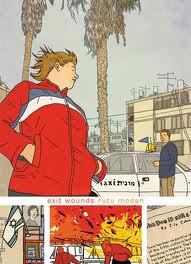Everyday grotesque
 Every once in a while I encounter a book that impresses me while simultaneously disappointing me by not reaching its potential. I stumbled across the NYT posts of Israeli comic artist and former editor of the Hebrew edition of MAD Magazine Rutu Modan more than a year ago and was completely enamored with her short graphic essays. Then this week I read Modan’s first full-length graphic novel, Exit Wounds.
Every once in a while I encounter a book that impresses me while simultaneously disappointing me by not reaching its potential. I stumbled across the NYT posts of Israeli comic artist and former editor of the Hebrew edition of MAD Magazine Rutu Modan more than a year ago and was completely enamored with her short graphic essays. Then this week I read Modan’s first full-length graphic novel, Exit Wounds.
The story, though interesting and well-crafted, seemed both too long to capture the intensity of the story it needed to tell, and yet too short to reach the conclusion it grasps at. Events in the plot happen too quickly, before the characters are developed enough to warrant investment. The urgency of events dissipates as the scenes are drawn out but not always filled in. The tragedy and excitement are dulled. The moment to draw the reader in suddenly and completely is fleeting, and too often it passes.
Exit Wounds is the story of a Israeli man, Koby, and his interactions with his estranged father’s much younger lover, Numi. Numi tracks Koby down when his father Gabriel’s continued disappearance in the wake of several suicide bombings has her fearing the worst. At the time of Gabriel’s disappearance from Numi’s life, Koby hasn’t spoken to or seen his father in several years.
Numi convinces Koby to help her investigate a recent bombing in which the body of one of the victims was burned beyond recognition. Numi, convinced the unidentified victim is Gabriel because she recognized a scarf she knit him among the television footage of the wreckage, doesn’t even consider alternate explanations for his disappearance. Numi has a likable hard-edged innocence. The purity of her devotion to Gabriel is naïve and endearing—she’s at that precarious moment before love has let her down and believes with complete conviction that the only thing that would keep her lover from calling her is an unforeseen tragedy.
Modan’s tale captures the small traumas of the everyday in the framework of a larger trauma. Modan perfectly illustrates a country in which suicide bombings happen in such quick and frequent succession that a woman must repeatedly clarify which bombing she suspects took her lover.
The title is of course fitting both literally and in reference to the exit wounds we suffer from when people take their leave from our lives. Nothing ever heals completely, least of all the emotional trauma of abandonment. If this sounds depressing, that’s because it really kind of is.
Modan’s characters are equally expressive and imperfect in both Exit Wounds and her visual blog, Mixed Emotions. This series of six brief memoirs showcase Modan and her family, especially her paternal grandmother who fled to Israel from Warsaw during the German occupation. Her characters are slightly lumpy and blemished, the antithesis of the polished diamond-eyed shine of Manga. My favorite post by Modan is “Queen of the Scottish Fairies”. The post chronicles Modan and her husband’s amusing struggle amongst themselves over their son’s love of tutus, dolls, and all things pink.
 The posts on Mixed Emotions examine glimpses of the every day. A trip to the hairdresser for Rutu and her grandmother provides the platform for her to examine the basis of their strained relationship. These graphic essays are short and poignant, just long enough to avoid gimmick and make an impact. The short form suits Modan’s story-telling style in a way that her book-length work didn’t quite accomplish.
The posts on Mixed Emotions examine glimpses of the every day. A trip to the hairdresser for Rutu and her grandmother provides the platform for her to examine the basis of their strained relationship. These graphic essays are short and poignant, just long enough to avoid gimmick and make an impact. The short form suits Modan’s story-telling style in a way that her book-length work didn’t quite accomplish.
In her Pretty Cool People Interview, Modan talks about the funny story about cancer she convinced the NYT Magazine they wanted her to write. The story she mentions is “The Murder of the Terminal Patient,” a seventeen chapter series that encompasses the death of a singer under mysterious circumstances and the ensuing investigation. But don’t go quoting me on that, friends, my information may or may not be from Wikipedia. I plan on reading “The Murder of the Terminal Patient” tonight after I Skype with my family while they eat Chinese food for my mom’s birthday (don’t let anyone tell you we don’t know how to have a good time).
As a bonus, Modan’s website hosted by Drawn and Quarterly looks a lot like something Adrian Tomine might draw!